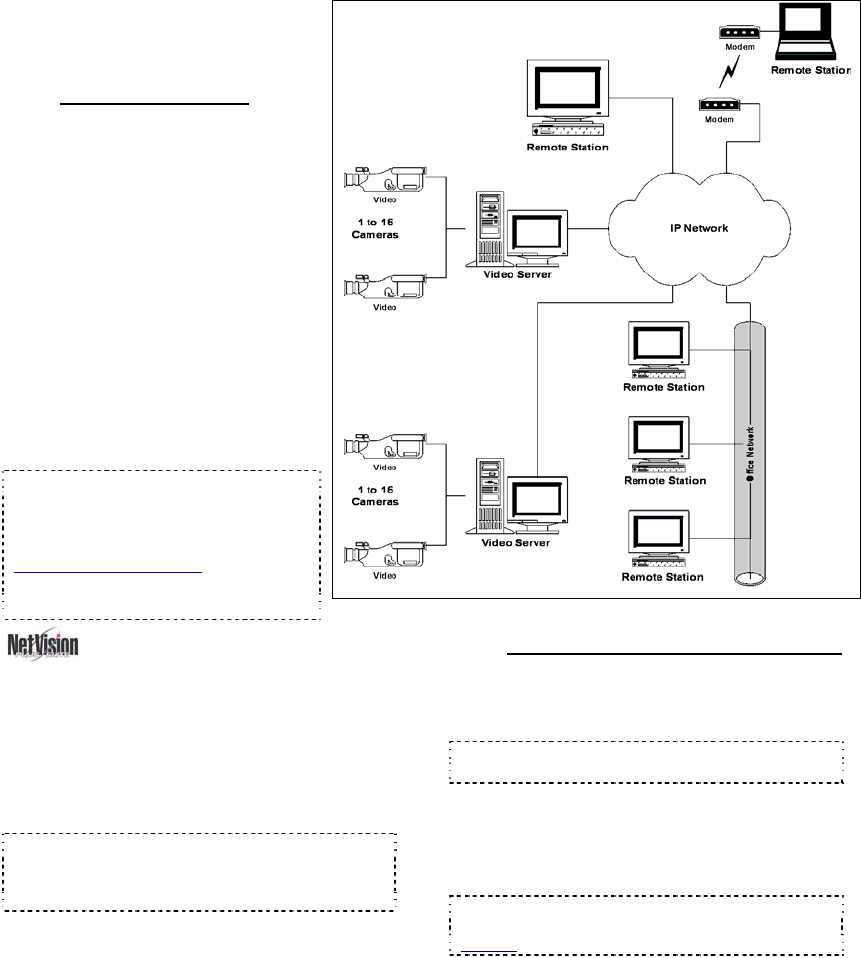User`s guide
Table Of Contents
- Copyrights and Trademarks
- Disclaimer
- Welcome to NetVision
- Common / Daily Tasks
- 5 Starting your Software and Logging In
- 6 Alarm / Reporting Features and 'Chatting'
- 7 Playing or Downloading Video Recordings
- 7.1 Overview--Types of Playback
- 7.2 Playback--Technical Details
- 7.3 Synchronized Playback (v2.3 SP2)
- 7.4 Video Search (v2.3 SP2)
- 7.5 Searching for Motion
- 7.6 Working with the Playback Screen
- 7.7 Viewing and Printing 'Snapshots'
- 7.8 Working with the File List
- 7.9 Quad Playback
- 7.10 Server Management--Identifying Remote Servers for Playback
- 8 Viewing Live Cameras
- 9 Recording Camera-Views
- System Administration and Maintenance
- 10 Tasks Applicable to Remote Stations and the Video Server
- 10.1 PC Date and Time
- 10.2 Checking your Software Version
- 10.3 Introduction to Video File Management (Filekeeping and Housekeeping)
- 10.4 To Allow Using a Blank CD (Roxio - Easy CD Creator 5 basic with DirectCD)
- 10.5 Filekeeping (v2.3 SP2)
- 10.6 Housekeeping
- 10.7 Automatic Video File Management (Self Housekeeping)
- 11 Tasks Performed at the Video Server Only
- 10 Tasks Applicable to Remote Stations and the Video Server
- System Configuration
- Software Installation and Network Set Up
- 19 PC Requirements
- 20 Software Installation or Upgrade
- 21 Network and Connectivity Issues
- 21.1 General Network Requirements
- 21.2 IP Addressing on the Network
- 21.3 Network Services
- 21.4 Network Ports
- 21.5 To Connect via the Internet
- 21.6 Remote User Permissions
- 21.7 For Remote Viewing, Recording, Playback, and/or Audio Monitoring
- 21.8 For Alarm Alerts
- 21.9 For E-Mail Alerts
- 21.10 Windows Dial-Up Networking Connection (i.e., not via the Internet)
- 21.11 Network Usage
- Reference Topics
- 22 Using the Small Remote Module
- 23 Remote Configuration
- 24 The WatchDog Feature
- 25 Hardware Reference
- 26 Troubleshooting
- 27 Using the ATM Interface Option
- 28 Working with the Older Playback Engines
- 28.1 The Video Playback Feature (Micro DVR)
- 28.2 Step 1: Open the Video Player
- 28.3 Step 2: Local / Remote, and Connection Screen
- 28.4 Step 3: Searching for Video/Alarm Files
- 28.5 Smart Motion Search (Micro DVR)
- 28.6 Step 4: Playing a Video
- 28.7 Window Options and File Properties (Micro DVR, Quad Player)
- 28.8 Viewing and Printing 'Snapshots' (Micro DVR)
- 29 Viewing Cameras through a Web Browser
- 30 Setting up an IP Camera or Video Server module (v2.3 SP2)
- 31 Panoramic Video Surveillance--PVS (v2.3 SP2)

2 NetVision Plus/Elite and Micro DVR v2.3 SP2 User's Guide 21-0400E v2.3.3
1
System Overview
1.1
System Overview:
Netvision™ is a remote digital
video surveillance capture and
reporting system accessible by
LAN/WAN, the Internet, or through
a dial-up networking connection.
The two main components of the
system are the Video Server (with
cameras) and remote stations.
The Video Server collects and
digitally records video input from
video cameras and allows viewing
it at remote surveillance stations
using an IP link (LAN/WAN,
internet, or dial-up networking).
Remote surveillance Stations are
video receivers that function as monitoring
consoles and enable a variety of
administrative, alarm and monitoring
functions. Remote monitoring tasks can
be carried out from anywhere you have
access to your network, the internet, or a
telephone.
The Video Server includes a computer, video
capture board(s), cameras, and software. Remote
surveillance stations include software typically
running on an existing/locally sourced Windows PC.
1.2
Additional components include:
• Video cameras (up to 16--using four capture
boards). Any of them can include PTZ
support.
Eight ports/PTZ protocols are supported, plus PTZ-
cascading (e.g., Canon VC-C4).
• Input / Output wiring harness;
• Microphone(s) for audio support at
camera(s)--can be monitored at remote
stations as well.
Tip: Current video server units typically include up
to 5 audio inputs.
Related: 25.1 Capture Board Reference
Note: Due to speed and reliability
considerations, dial-up connections are
NOT recommended. Use a faster
connection if you have a choice.
Video Server Models: Different
NetVision Video Servers are available,
supporting 4, 8, or 16 cameras.










